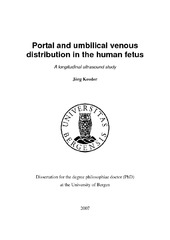| dc.contributor.author | Kessler, Jörg | en_US |
| dc.date.accessioned | 2007-10-18T11:07:34Z | |
| dc.date.available | 2007-10-18T11:07:34Z | |
| dc.date.issued | 2007-06-26 | eng |
| dc.identifier.isbn | 978-82-308-0392-9 (print version) | en_US |
| dc.identifier.uri | https://hdl.handle.net/1956/2392 | |
| dc.description.abstract | Knowledge of the venous perfusion of the human fetal liver is fragmentary and mainly limited to the umbilical circulation. Current ultrasound technology makes it possible to study blood flow noninvasively and to give new insights into the developmental changes during gestation. AIMS: The general aim of the study was to map the hemodynamics of the venous supply to the fetal liver in humans. In detail: to establish longitudinal reference ranges for ductus venosus flow velocities and waveform indices (paper I), to establish a technique for direct flow measurement in the main portal stem and study its development during the second half of pregnancy (paper II), to assess the flow velocity pattern in the left portal vein (paper III), and to determine the distribution of venous blood supply within the liver and explore the impact of maternal and fetal factors (paper IV). MATERIAL AND METHODS: After informed written consent, 160 women with low-risk pregnancies were recruited to a longitudinal study according to a protocol approved by the Regional Committee for Research Ethics (REK-Vest 04/3837). 4-5 ultrasound examinations, each lasting 60 minutes, were done at four weeks intervals between 20 and 40 weeks of gestation. At each session the inner diameter was measured in: 1. the intraabdominal portion of the umbilical vein, 2. the ductus venosus, 3. the main portal stem, and 4. the left portal vein. In the same vessels, time-averaged maximum flow velocties were measured by Doppler ultrasound. Volume blood flow was calculated and normalised for fetal weight. Mean and percentile curves were constructed using regression analysis and multi-level modelling. The impact of maternal and fetal factors on liver blood flow was investigated by deviance statistics. RESULTS: The established longitudinal reference ranges for ductus venosus flow velocities and waveform indices allow the calculation of conditional percentiles, which are narrower and commonly shifted compared to those of the entire population (Paper I). Blood flow in the main portal stem was pulsatile in 99%. Both diameter and flow velocities doubled during the observation period. Correspondingly, blood flow increased throughout gestation, and so did flow, normalised for fetal weight (Paper II). Flow velocities in the left portal branch increased throughout gestation. We found pulsatile flow in 69%, usually directed towards the right lobe. However, intermittent flow reversal occurred during respiratory movements, and continuous reversal in 8% of the observations close to term (Paper III). Total venous liver flow increased throughout gestation, while normalised flow decreased. Lobe specific flow distribution was stable during gestation directing 60% of the total venous liver flow to the left and 40% to the right lobe. The umbilical vein was the dominating venous blood source, but the portal fraction grew during the last trimester. Venous liver flow and its components were related to birthweight, while lobe specific flow and fractional flow distribution to the lobes were related to pregnancy weight gain (Paper IV). CONCLUSION: We have established longitudinal reference ranges for all components of venous liver supply and the ductus venosus in the human fetus. The reference ranges for ductus venosus velocimetry are appropriate for serial measurements, especially when conditional terms are applied (Paper I). The present established technique of assessing flow in the main portal stem had a high success rate and could be used to show an increasing hemodynamic importance of the main portal stem towards term (Paper II). The umbilico-portal watershed is usually situated in the right liver lobe, but may shift towards the left portal vein even in circulatory uncompromised fetuses. The time-averaged maximum flow velocity is suggested for the evaluation of the umbilico-portal watershed (Paper III). The relationship between venous liver flow and birth weight may indicate a link between liver perfusion and fetal growth. The growing portal fraction of the total venous blood flow signifies the high circulatory priority given to the splanchnic circulation close to term. The relationship between low pregnancy weight gain and the distributional shift in favour of left liver lobe perfusion may be part of an adaptation to various intrauterine environments (Paper IV). | en_US |
| dc.language.iso | eng | eng |
| dc.publisher | The University of Bergen | eng |
| dc.relation.haspart | Paper I: Ultrasound in Obstetrics and Gynecology 28, Kessler, J.; Rasmussen, S.; Hanson, M.; Kiserud, T., Longitudinal reference ranges for ductus venosus flow velocities and waveform indices, pp. 890-898. Copyright 2007 ISUOG. Published by John Wiley & Sons, Ltd. Full-text not available due to publisher restrictions. Published version available at: <a href="http://dx.doi.org/10.1002/uog.3857"target=_blank>http://dx.doi.org/10.1002/uog.3857</a> | en_US |
| dc.relation.haspart | Paper II: Kessler, J.; Rasmussen, S.; Kiserud, T., The fetal portal vein – normal blood flow development during the second half of the human pregnancy. Published in Ultrasound in Obstetrics and Gynecology 30(1): 52-60. Copyright ISUOG. Published by John Wiley & Sons, Ltd. Full-text not available due to publisher restrictions. Published version available at: <a href="http://dx.doi.org/10.1002/uog.4054"target=_blank>http://dx.doi.org/10.1002/uog.4054</a> | en_US |
| dc.relation.haspart | Paper III: Kessler, J.; Rasmussen, S.; Kiserud, T., The left portal vein as a watershed of the fetal circulation: development during the second half of pregnancy and suggested method of evaluation. Preprint. Accepted for publication in Ultrasound in Obstetrics and Gynecology. Copyright ISUOG. Published by John Wiley & Sons, Ltd. | en_US |
| dc.relation.haspart | Paper IV: Kessler, J.; Rasmussen, S.; Godfrey, K. M.; Hanson, M.; Kiserud, T., Longitudinal study of umbilical and portal venous blood flow to the fetal liver: low pregnancy weight gain is associated with preferential supply to the left fetal liver lobe. Preprint. Submitted to Pediatric Research. Published by Lippincott Williams and Wilkins for the International Pediatric Research Foundation. Full-text not available due to publisher restrictions. Published version available at: <a href="http://dx.doi.org/10.1203/PDR.0b013e318163a1de"target=_blank>http://dx.doi.org/10.1203/PDR.0b013e318163a1de</a> | en_US |
| dc.title | Portal and umbilical venous distribution in the human fetus : a longitudinal ultrasound study | en_US |
| dc.type | Doctoral thesis | |
| dc.subject.nsi | VDP::Medisinske Fag: 700::Klinisk medisinske fag: 750::Gynekologi og obstetrikk: 756 | nob |

